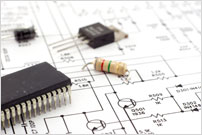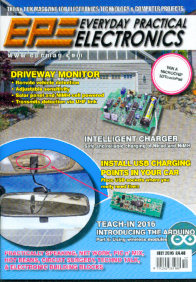July 2016 Issue
A summary of this month's contents.
Driveway Monitor (Part 1)

This project detects a vehicle’s movement by using a Honeywell magneto-resistive sensor located alongside a driveway, for example. It pinpoints disturbances in the Earth’s magnetic field created when a vehicle passes by, and it sends a wireless signal to a receiver which activates a piezo sounder and led. The direction of travel can also be determined.
It is low maintenance, with a solar-rechargeable detector. The article also describes how a magneto-resistive sensor works. PIC 16F88 microcontroller-powered with source code downloadable from our web site. Part One describes the receiver and detector circuitry, and Part Two next month has full assembly details.
Install USB Charging Points in your car
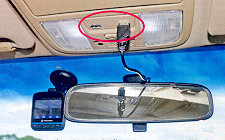 New cars often have more than one USB-style socket for powering devices but older cars have none and motorists are forced to rely on using a Christmas-tree of cigarette-lighter chargers instead.
New cars often have more than one USB-style socket for powering devices but older cars have none and motorists are forced to rely on using a Christmas-tree of cigarette-lighter chargers instead.
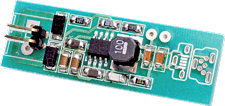 This project is a tiny PCB that offers two USB supplies. With care, it can be mounted in the courtesy light (dome light) housing, for example, where it will conveniently power a satnav or dashcam recorder.
This project is a tiny PCB that offers two USB supplies. With care, it can be mounted in the courtesy light (dome light) housing, for example, where it will conveniently power a satnav or dashcam recorder.
Intelligent Charger
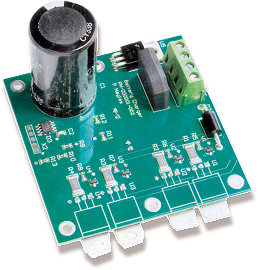
This project is based on a commercial board that offers safe and reliable automatic charging of Ni-Cd and Ni-MH cells. Its advanced algorithms make it ideal for cordless power tools, model racing cars, battery appliances, electric planes or just about anything that uses these types of rechargeable cell.
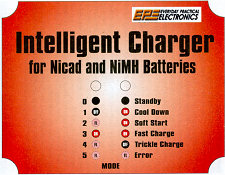
The article also has some interesting background information about handling and treating rechargeable cells, plus modifications that allow constructors to adapt it for their own applications.
![]() Please note this is a commercial microcontroller design and no source code has been made available.
Please note this is a commercial microcontroller design and no source code has been made available.
Introducing the Arduino
Part 6: Wireless Communications
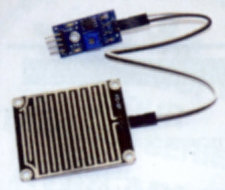 Our series dedicated to using the Arduino microcontroller module continues, this month showing how the Arduino can communicate with remote devices by using low-cost wireless modules.
Our series dedicated to using the Arduino microcontroller module continues, this month showing how the Arduino can communicate with remote devices by using low-cost wireless modules.
A popular 2.4GHz transceiver is examined, and our Arduino Workshop shows how to configure a wireless data link. In Coding Quickstart, the RadioHead library is outlined. Then as a practical application, a wireless-linked Arduino Uno Rain Alarm is described. There’s lots to see and do in our Teach-In tutorial, so if you want to get to grips with the Arduino then this series is the perfect introduction!
PIC n’ MIX
Our professional PIC microcontroller expert Mike O’Keefe continues his superb beginner’s guide to using PICs and the PICkit3, explaining the operation of the MPLAB X IDE for Windows. This invaluable and up-to-date insight into PICs is essential reading for anyone wanted to get started with them.
Also in this issue:
- Techno Talk – controlling the path of light in a silicon chip; the invention of the light relay, patented in Russia in 1927
- Net Work – the VR Box 2 VR viewer, using car dashcams with Bing
- Practically Speaking – the ins and outs of choosing and building electronic kits bought online
- Circuit Surgery – an intensive primer in State Machines (Part 2)
- Max’s Hot Beans – Max discovers a gadget that identifies electronic components
- Electronic Building Blocks – a hand-powered LED torch made from a stepper motor.
Next month
Low-cost, Accurate Voltage/ Current Resistance Reference; USB power monitor; Driveway Monitor (Part 2); Teach- In 2016 (Part 7) - Arduino Nano.
EPE is packed with practical electronics projects and theory for the hobbyist. You can order a printed copy of EPE for delivery to your door (worldwide), or try the PDF Version (needs Adobe Reader for Windows), or the Pocketmags for your mobile device. Subscribe now!
Source code file 0716.zip
 Download Help
Download Help
Can't find what you're looking for? Our Library Help Page offers extensive information and help with downloading files.

The July 2006 issue had PIC Sudoku; Digital Instrument Display for Cars (Part 2); a PC Power Monitor and a High-Current 13.5V PSU made from a PC PSU.
PCB artwork
As from July 2013 issue PCB artwork is available free to subscribers only.
Non-subscribers may purchase artwork files for a nominal sum. Please contact our Orders Dept for information or to place an order.
EPE Printed Circuit Boards
We can supply ready-made printed circuit boards (8-digit order codes) to the original design specification via mail order or from our Online Shop.

